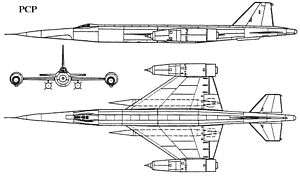Tsybin RSR
| RSR | |
|---|---|
 | |
| Orthographically projected diagram of the Tsybin RSR | |
| Role | Reconnaissance aircraft |
| Manufacturer | Tsybin |
| Designer | P. V. Tsybin |
| First flight | 7 April 1959 |
| Status | Prototype/project |
| Primary user | USSR |
The Tsybin RSR (Reactivnyi Strategicheskii Razvedchik) was a Soviet design for an advanced, long-range, Mach 3 strategic reconnaissance aircraft.
Development and design
In 1954, the design bureau headed by Pavel Tsybin started development of a ramjet-powered supersonic strategic bomber, the RS. This design proved impracticable, and a smaller derivative, the 2RS was proposed, which would achieve intercontinental range by being air-launched from a modified Tupolev Tu-95 bomber.[1]
This too was unsuccessful, with the aircraft unable to return to base if used on an intercontinental mission,[1] while being incapable of carrying a thermonuclear bomb.[2] The design was therefore revised again to a reconnaissance aircraft capable of operating from conventional runways, the RSR. As ramjets could not be used for take-off, they were replaced by turbofans.[1]
The RSR was primarily of aluminium construction, with a long circular-section fuselage, which housed a pressurized cabin for the pilot together with cameras and fuel, with thin, low-aspect-ratio trapezoidal wings. The engines, two Soloviev D-21 turbofans, were mounted at the tips of the wings. The aircraft had a bicycle undercarriage, with outriggers under the engine nacelles. It was planned to cruise at greater than Mach 2 at a height of 20,000 m (65,600 ft) giving a range of 3,760 km (2,340 mi).[3]
A simplified, full-sized aerodynamic prototype for the novel layout, the NM-1 was built in 1957. Intended for low-speed handling tests, the NM-1 had a steel-tube fuselage with duraluminium and plywood skinning.[4] This aircraft, powered by two Mikulin AM-5 turbojets first flew on 7 April 1959.[3] Based on the results of these trials, the RSR was redesigned (as the R-020) to make it more manoeuvrable at high altitude (it was proposed to carry out barrel rolls to avoid surface-to-air missiles).[5] More conventional Tumansky R-11 turbojets (the engine used in the MiG-21) replaced the unavailable Soloviev turbofans. Five R-020 airframes were virtually complete, only awaiting engines by April 1961, with another 10 planned, when Soviet Premier Nikita Khrushchev cancelled the program.
Specifications (NM-1)
Data from The Osprey Encyclopedia of Russian Aircraft 1875–1995[6]
General characteristics
- Crew: One
- Length: 26.57 m (87 ft 3¼ in)
- Wingspan: 10.48 m (34 ft 4⅝ in)
- Height: ()
- Wing area: 64 m²[7] (689 ft²)
- Empty weight: 6,355 kg (14,010 lb)
- Loaded weight: 9,000 kg (19,800 lb)
- Powerplant: 2 × Mikulin AM-5 turbojet, 49 kN (4,410 lbf)2,000 kgf each
Performance
- Maximum speed: Mach 3
- Service ceiling: 4,000 m[7] (13,000 ft)
See also
Aircraft of comparable role, configuration and era
References
Notes
Bibliography
- Butowski, Piotr. "Steps Towards 'Blackjack': Soviet supersonic intercontinental bombers before the Tu-144". Air Enthusiast. No. 73, January - February 1998. Stamford, Lincolnshire: Key Publishing. Page 36-49. ISSN 0143-5450.
- Gunston, Bill. The Osprey Encyclopedia of Russian Aircraft 1875 - 1995. London: Osprey, 1995. ISBN 1-85532-405-9.
- "Plane Facts:Soviet strategic reconnaissance". Air International, February 1977, Vol 12 No 2. Bromley, UK:Fine Scroll. p. 98.